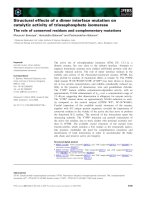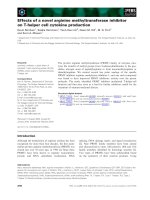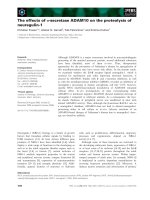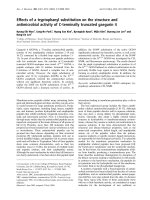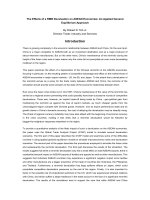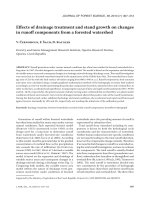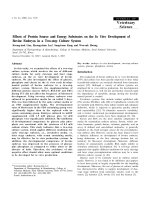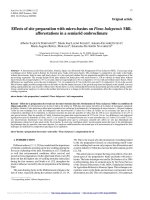Effects of a job crafting intervention program on work engagement among Japanese employees: A pretest-posttest study
Bạn đang xem bản rút gọn của tài liệu. Xem và tải ngay bản đầy đủ của tài liệu tại đây (670.58 KB, 9 trang )
Sakuraya et al. BMC Psychology (2016) 4:49
DOI 10.1186/s40359-016-0157-9
RESEARCH ARTICLE
Open Access
Effects of a job crafting intervention
program on work engagement among
Japanese employees: a pretest-posttest
study
Asuka Sakuraya1*, Akihito Shimazu1, Kotaro Imamura1, Katsuyuki Namba2 and Norito Kawakami1
Abstract
Background: Job crafting, an employee-initiated job design/redesign, has become important for employees’ well-being
such as work engagement. This study examined the effectiveness of a newly developed job crafting intervention
program on work engagement (as primary outcome), as well as job crafting and psychological distress (as secondary
outcomes), using a pretest-posttest study design among Japanese employees.
Methods: Participants were managers of a private company and a private psychiatric hospital in Japan. The
job crafting intervention program consisted of two 120-min sessions with a two-week interval between them.
Outcomes were assessed at baseline (Time 1), post-intervention (Time 2), and a one-month follow-up (Time 3). The
mixed growth model analyses were conducted using time (Time 1, Time 2, and Time 3) as an indicator of intervention
effect. Effect sizes were calculated using Cohen’s d.
Results: The program showed a significant positive effect on work engagement (t = 2.20, p = 0.03) in the mixed
growth model analyses, but with only small effect sizes (Cohen’s d = 0.33 at Time 2 and 0.26 at Time 3). The program
also significantly improved job crafting (t = 2.36, p = 0.02: Cohen’s d = 0.36 at Time 2 and 0.47 at Time 3) and reduced
psychological distress (t = −2.06, p = 0.04: Cohen’s d = −0.15 at Time 2 and −0.31 at Time 3).
Conclusions: The study indicated that the newly developed job crafting intervention program was effective in
increasing work engagement, as well as in improving job crafting and decreasing psychological distress, among
Japanese managers.
Trial registration: UMIN Clinical Trials Registry UMIN000024062. Retrospectively registered 15 September 2016.
Keywords: Intervention, Job crafting, Psychological distress, Work engagement
Background
Today’s organizations require their employees to be
motivated, proactive, responsible, and involved. In other
words, modern work organizations need engaged employees [1, 2].
Work engagement is defined as an active, positive,
work-related state of mind characterized by vigor, dedication, and absorption [3, 4]. According to empirical
studies with longitudinal designs [5–8], engaged workers
* Correspondence:
1
Department of Mental Health, Graduate School of Medicine, The University
of Tokyo, 7-3-1, Hongo, Bunkyo-ku, Tokyo 113-0033, Japan
Full list of author information is available at the end of the article
show low psychological distress, few physical complaints,
and high employee performance. In addition, a metaanalytic study [9] showed that work engagement is negatively related to turnover intention and positively related to
employee performance and organizational commitment.
The number of intervention studies aimed at improving work engagement is increasing. Although seven randomized controlled trials (RCTs) have been conducted
since 2012, only two studies showed an improvement of
work engagement at follow-up.
For instance, Coffeng et al. (2014) conducted an
intervention to change the physical work environment
(e.g., creating a coffee corner) and found a significant
© The Author(s). 2016 Open Access This article is distributed under the terms of the Creative Commons Attribution 4.0
International License ( which permits unrestricted use, distribution, and
reproduction in any medium, provided you give appropriate credit to the original author(s) and the source, provide a link to
the Creative Commons license, and indicate if changes were made. The Creative Commons Public Domain Dedication waiver
( applies to the data made available in this article, unless otherwise stated.
Sakuraya et al. BMC Psychology (2016) 4:49
improvement of absorption, a component of work engagement [10]. However, they did not find a significant improvement in overall work engagement (i.e., total score of
Utrecht Work Engagement scale) [10]. Another example
is the study of Imamura and his colleagues (2015), in
which internet cognitive behavioral therapy (iCBT) was
employed. Although they showed a significant improvement of work engagement at six-month follow-up, its effect size was small (0.16) [11].
One possible reason why previous studies failed to find
an intervention effect on work engagement (or found
only a small one) is that they did not employ strategies
to simultaneously improve the two resources of work
engagement – that is, job resources and personal resources [1, 8]. Specifically, those studies employed programs changing the physical work environment [10],
programs improving psychological resources through
cognitive behavioral therapy [11], career management
skill workshops [12], mindfulness training sessions
[13, 14], or lifestyle change programs [15, 16]. These
programs only focused on one or the other of the
two resources. Hence, if a program were to focus on
both job and personal resources at the same time, a
better intervention effect might be obtained.
Job resources include physical, social, or organizational
aspects of the job that help individuals to achieve their
working goals; stimulate personal growth, learning, and
development; or reduce job demands or associated physical or psychological costs, such as support from colleagues and opportunity for development [17]. Personal
resources are positive self-evaluations that are linked to
resiliency and refer to individuals’ sense of their ability
to successfully control and have an impact on their environment, such as self-efficacy and optimism characteristics [8, 18, 19].
Job crafting – that is, employee-initiated design/redesign of work characteristics – can be conceptualized
as a personal resource. According to Wrzesniewski and
Dutton (2001), job crafting is defined as “the physical
and cognitive change individuals make in the task or relational boundaries of their work” [20]. Job crafting consists of the following three components: changing the
job’s boundaries (task crafting), changing the relational
boundaries (relational crafting), and changing the cognitive task boundaries (cognitive crafting) [20, 21]. Because
task crafting or relational crafting can lead to designing
and improving one’s work and social environment in the
workplace [20, 22], an intervention program that focuses
on these components of job crafting may be effective for
increasing job resources as well. Indeed, previous observational studies have reported that job crafting was
positively associated with job resources and work
engagement [23–25] and negatively associated with
burnout, an opposite aspect of work engagement [23].
Page 2 of 9
Therefore, a job crafting intervention program may
be effective to increase work engagement.
To date, there have been only three non-randomized
controlled trials of job crafting program, which composed
of two or three group sessions [26–28]. For instance,
Wingerden et al. (2016) showed the significant effect of
the intervention on work engagement, psychological capital, and in-role performance [28]. However, the other two
studies found no significant intervention effects on job resources (opportunities for development and leader–member exchange), personal resource (self-efficacy), positive/
negative affect at work [27], or work engagement, performance [26]. Accordingly, we may say that the effect of
job crafting intervention on work-related outcome is unclear. In addition, all of the previous interventions focused
only on changing job resources or demands, and were not
fully based on the original concept of job crafting by
Wrzesniewski and Dutton [20].
The aim of this study was to investigate the effectiveness of a newly developed job crafting intervention program on work engagement among Japanese employees
with a pretest-posttest study design. We expect that the
scores of job crafting (for manipulation check) and work
engagement (primary outcome) will increase at Time 2
(post-intervention) and at Time 3 (one-month followup) than compared to Time 1 (baseline). In addition, the
score of psychological distress (secondary outcome) will
decrease at Time 2 and Time 3 compared to Time 1.
The strong point of this program is that it focuses on
three types of job crafting (i.e., task, relation, and cognition) based on the concept of Wrzesniewski and Dutton
[20], which may be useful to increase work engagement.
Methods
Study design
A pre- and post-intervention study was conducted.
There was no control group because it was difficult to
set due to the condition of the participant organizations.
Therefore, we put this study as a pilot study to investigate
the effectiveness of our job crafting intervention preliminarily. The study protocol was registered retrospectively at
the UMIN Clinical Trials Registry (UMIN-CTR) (ID =
UMIN000024062). The ethics review board of The
University of Tokyo Graduate School of Medicine/
Faculty of Medicine approved the procedures before
the start of the study (the reference number: 10749).
This manuscript was reported according to the
TREND statement checklist [29].
Participants
This study was carried out from August to November
2015 at two private companies in Japan. We recruited all
full-time managers in a manufacturing company (n = 54)
and managers who belonged to seven selected
Sakuraya et al. BMC Psychology (2016) 4:49
departments at a private psychiatric hospital (n = 25).
Participants were approached by a contact person in
their own company or hospital using an e-mail invitation
or a poster. The inclusion criterion for participants was
regular (full time) employment; workers with non- regular (part time) employment and reemployment in a temporary position were excluded.
Interventions
The intervention program, which was based on the job
crafting theory of Wrzesniewski and Dutton (2001)
[20], was developed through literature review [20–25],
discussion with occupational health professionals, and
interview with employees on how they craft their own
job in their working lives, such as changing the relationships with others or reframing the significance of
their work. One of the unique features of the program,
compared to previous job crafting interventions [26–28],
was that it contains three aspects of job crafting (i.e.,
task, human relation, and cognition), which may be important to work engagement. The program consisted of
two 120-min sessions with a two-week interval between
them and was conducted by one researcher (the first
author) and one clinical psychologist. The two training
sessions were held in a room at the worksite in a group
setting with 9–13 participants during working hours in
the company, separately for department 1 (first session
n = 11, second session n = 9), department 2 (n = 12 and
13, respectively), and department 3 (n = 12 and 12, respectively). The sessions were conducted outside of
working hours in the hospital (n = 13 and 10, respectively). In the first session, following the introduction of
the idea of job crafting including task, relational or cognitive crafting, by the researcher, participants learned
the concept of job crafting from a case study (30 min),
shared their personal crafting stories in their own working lives (30 min), and made their own individual job
crafting plans (task crafting, relational crafting, and
cognitive crafting) for the next two weeks (30 min).
They were also provided with a homework booklet for
a job crafting exercise. During the two weeks between
the first and second sessions, they were encouraged to
implement their job crafting plans. In the second session, each participant reviewed his/her own job crafting
plan individually (15 min); the participants then shared
their reflections as a group (30 min), discussed what
job crafting would be feasible and sustainable to practice (30 min), and, finally, made a modified job crafting
plan (30 min). Participants who could not attend first
session were distributed the material of the session and
asked to make their job crafting plan and practice it before they attend the second session. Thus, they could
attend the second session. There was no incentive offered for participation in the program.
Page 3 of 9
Outcomes
All data were collected using a web-based self-report
questionnaire at baseline, post-intervention, and onemonth follow-up.
Primary outcome
Work engagement
Work engagement was assessed using the Japanese version of the Utrecht Work Engagement Scale (UWES),
which has been reported to be reliable and valid [30]. It
comprises 9 items assessing vigor (3 items; e.g., ‘At my
work, I feel bursting with energy.’), dedication (3 items;
e.g., ‘My job inspires me.’), and absorption (3 items; e.g.,
‘I get carried away when I am working.’). All items were
rated on a seven-point Likert scale ranging from 0
(never) to 6 (always), and the total score for each
subscale was divided by the number of items to get
an average score.
Secondary outcomes
Psychological distress
Psychological distress was measured using the Brief Job
Stress Questionnaire (BJSQ) [31], comprising 15 items
assessing irritation (3 items; e.g., ‘I feel anger’), fatigue (3
items; e.g., ‘I feel very tired’), anxiety (3 items; e.g., ’I feel
uneasy’), and depression (6 items; e.g., ‘I feel depressed’).
All items were measured on a four-point Likert scale
ranging from 1 (never) to 4 (almost always), and the
total score was calculated by dividing the sum of item
scores by the number of items in the present study.
Manipulation check of the intervention
Job crafting
Job crafting was assessed using a scale developed by
Sekiguchi and his colleagues [21] based on the
conceptualization by Wrzesniewski and Dutton (2001)
[20], which has been reported to be reliable and valid
[21]. It comprises 12 items assessing three subscales:
task crafting (4 items; e.g., ‘Add or reduce tasks so that
my job can be performed more smoothly’), relational
crafting (4 items; e.g., ‘Actively interact with people
through my job’), and cognitive crafting (4 items; e.g.,
‘Reframe my job as significant and meaningful’). All
items were measured on a seven-point Likert scale ranging from 1 (strongly disagree) to 7 (strongly agree), and
the total score, as well as each subscale score, was calculated by dividing the sum of item scores by the number
of the items.
Demographic characteristic
Demographic variables included age, gender (0 = male,
1 = female), marital status (0 = married, 1 = not married),
educational attainment (0 = university or higher, 1 = high
school or some college), and working hours per week were
Sakuraya et al. BMC Psychology (2016) 4:49
Page 4 of 9
collected. These variables could be possibly confounded in
the association between work-related variables and employee well-being [1, 21, 23, 32, 33]. A close investigation
of the responses to work hours revealed that some respondents reported less than 35 h per week, while all respondents were employed full-time. These responses were
coded as missing values.
Sample size
The estimated sample size was 66 participants to detect
an effect size (Cohen’s d) of 0.35 or greater for work engagement, at an alpha error rate of 0.05 (two-tailed) and
a beta error rate of 0.20 using the G*Power 3 program
[34, 35]. No previous studies have reported an effect size
of the job crafting intervention program for work engagement. However, referring to a previous study [27]
that showed the effect size (Cohen’s d) for self-efficacy
and job-related affective well-being, it seemed reasonable
to set 0.35 as an expected effect size in our job crafting
intervention program.
Statistical methods
The analysis was performed at the individual level. A
mixed model for repeated measures conditional growth
model analysis over time (baseline, post-intervention,
and one-month follow-up) was conducted to test the effect of the intervention. The mixed model is useful to
understand changes in human behavior over time because of higher-level clustering unit (i.e., time) [36, 37].
First, we applied several mixed models to the data: random intercept and random slope; random intercept only;
and random slope only. A converged model that showed
the smallest AIC (Akaike Information Criterion), an indicator of goodness of fit of the model, was selected. If
these mixed models did not converge, a fixed model was
used. The linear mixed model in SPSS Statistics 22.0
(SPSS Inc, Chicago, IL) was used. Also, the effect sizes
and the 95 % confidence intervals (95 % CIs) were calculated using Cohen’s d only among those who completed
the questionnaire at post-intervention or follow-up, although the effect sizes may be biased due to drop-outs
[38, 39]. Values of 0.2, 0.5, and 0.8 are generally interpreted as being suggestive of small, medium, and large
effects, respectively [39].
Fig. 1 Participants flow diagram. Participants were recruited from
one company and one hospital in Japan; all senior staff in company
A (n = 54) and supervisors who belonged to seven selected
departments at the private psychiatric hospital B (n = 25). 50
employees (63.3 %) participated in this study
(88 %) completed the second session, and 42 (84 %)
completed all session.
Baseline data
Demographic characteristics of participants in subgroups
and total are presented in Table 1. In the whole sample,
most were males, middle-aged and married; more than
half received high school or some college education.
Working hours per week were reported from 42 participants in the total, with the average of 45.9 h per week,
ranging from 35 to 60. Proportion of males and average
age were significantly greater for participants from the
manufacturing company than those from the private
psychiatric hospital (p < .05 and p < .01, respectively); no
significant difference was observed in other variables between the two groups (p > .05). There were also no significant differences in demographic characteristics at baseline
between those who completed surveys (n = 39) and those
who did not complete all surveys (n = 11) (p > .05).
Means (SDs) of outcome variables at baseline,
post-intervention and one-month follow-up
Table 2 shows the means and standard deviations of the
outcome variables at baseline (Time 1), post-intervention
(Time 2), and one-month follow-up (Time 3). The means
of work engagement, job crafting (total), and all subscales
of job crafting tended to increase over time constantly,
whereas that of psychological distress tended to decrease
over time.
Results
Participant flowchart
The participant flowchart is shown in Fig. 1. A total of
50 employees participated in this study and completed
the baseline survey (Time 1). Of those, 44 participants
(88 %) and 42 participants (84 %) completed the postintervention survey (Time 2) and the one-month
follow-up survey (Time 3), respectively. For the process
evaluation, 48 (96 %) completed the first session, 44
Effects on outcome variables
Effect on work engagement
Table 3 shows the estimated effects of the job crafting
intervention program on the outcome variables on the
basis of the mixed model analyses. Any of the models including random effects did not converge. The results
from the model including only fixed effects were reported here. The job crafting intervention program
Sakuraya et al. BMC Psychology (2016) 4:49
Page 5 of 9
Table 1 Characteristics of participants from two work places in Japan (N = 50)
A manufacturing company (n = 36)
A private psychiatric hospital (n = 14)
Total (N = 50)
n
(%)
n
(%)
n
Male
34
(94.4)
8
(57.1)
42
(84.0)
Female
2
(5.6)
6
(42.9)
8
(16.0)
Mean
SD
Mean
SD
(%)
Mean
SD
46.3
8.5
45.9
5.9
Gender
Age (Years)
49.4
6.2
38.4
8.7
Educational attainment
University or higher
13
(36.1)
8
(57.1)
21
(42.0)
High school or some college
23
(63.9)
6
(42.9)
29
(58.0)
Married
29
(80.6)
11
(78.6)
40
(80.0)
Not married
7
(19.4)
3
(21.4)
10
(20.0)
Marital status
Working hours per weeka
45.4
6.0
47.9
5.5
a
The mean and standard deviation of working hours per week was calculated for 33 and 9 participants from a manufacturing company and a private psychiatric
hospital, respectively, who had no missing response on this variable
showed a significantly positive effect on work engagement before and after adjustment of covariates (t = 2.23,
p = 0.03; t = 2.20, p = 0.03). The effect sizes were small
and significant at post-intervention (Time 2): Cohen’s
d = 0.33 (95 % CI, 0.03 to 0.62), but not significant at
one-month follow-up (Time 3) Cohen’s d = 0.26 (95 %
CI, −0.04 to 0.56).
Effect on psychological distress
The program showed a significantly favorable effect on
psychological distress before and after adjusting the covariates (t = −2.07, p = 0.04; t = −2.06, p = 0.04). The effect
sizes were small and non-significant at post-intervention
(Time 2): Cohen’s d = −0.15 (95 % CI, −0.44 to 0.15), but
significant at one-month follow-up (Time 3): Cohen’s
d = −0.31 (95 % CI, −0.62 to −0.01).
Effect on job crafting
The program showed a significantly positive effect on job
crafting before and after adjusting the covariates (t = 2.37,
p = 0.02; t = 2.36, p = 0.02), with small effect sizes at postintervention (Time 2) (Cohen’s d = 0.36, 95 % CI, 0.06
to 0.65) and at one-month follow-up (Time 3) (Cohen’s
d = 0.47, 95 % CI, 0.17 to 0.77). For the subscales, the
program also showed a significant effect on cognitive
crafting before and after adjustment of covariates (t = 2.75,
p = 0.01; t = 2.76, p = 0.01), with small effect sizes at postintervention (Time 2) (Cohen’s d = 0.34, 95 % CI, 0.04 to
0.64) and at one-month follow-up (Time 3) (Cohen’s d =
0.56, 95 % CI, 0.26 to 0.86). On the other hand, the program did not show significant effects on task crafting or
relational crafting (p > .05); in addition, effect sizes were
small and not significant, excepting for task crafting at
one-month follow-up (Time 3) (Cohen’s d = 0.32, 95 % CI,
0.02 to 0.62).
Discussion
The present pretest-posttest study examined the effects
of a newly developed job crafting intervention program
on work engagement and other outcomes (i.e., job crafting and psychological distress) among Japanese employees. The novel aspect of the current program is that
it contains three factors of job crafting, such as task, relational, and cognitive crafting, which focuses on improving two preceding factors of work engagement (i.e.,
personal and job resources) [20]. The study found a significantly favorable effect of the program on work
Table 2 Means (SDs) of outcome variables at baseline, post-intervention and one-month follow-upa
Range
Time 1 (N = 50)
Work engagement
0–6
2.61
(0.74)
2.74
(0.83)
2.79
(0.91)
Job crafting (total)
1–7
4.73
(0.83)
4.91
(0.95)
4.98
(0.80)
Task crafting
1–7
4.93
(0.93)
5.06
(0.98)
5.09
(0.79)
Relational crafting
1–7
4.89
(0.97)
5.02
(1.02)
5.06
(0.94)
Cognitive crafting
1–7
4.38
(1.10)
4.66
(1.17)
4.80
(0.95)
Psychological distress
1–4
2.02
(0.69)
1.92
(0.72)
1.82
(0.62)
a
Time 1, baseline; Time 2, post intervention; Time 3, one-month follow-up
Time 2 (N = 44)
Time 3 (N = 42)
Sakuraya et al. BMC Psychology (2016) 4:49
Page 6 of 9
Table 3 Effects of a job crafting intervention program on work engagement, job crafting, and psychological distress in the mixed
growth model analyses for the whole sample (N = 50)
Estimates of fixed effects (Adjusted)a
Estimates of fixed effects (Crude)
Effect
t
p
95 % CI
lower
Effect
t
p
upper
95 % CI
lower
upper
Work engagement
0.11
2.23
0.03
0.01
0.21
0.11
2.20
0.03
0.01
0.21
Job crafting
0.13
2.37
0.02
0.02
0.25
0.13
2.36
0.02
0.02
0.25
Task crafting
0.08
1.28
0.20
−0.04
0.20
0.08
1.25
0.21
−0.05
0.20
Relational crafting
0.09
1.28
0.20
−0.05
0.23
0.09
1.28
0.20
−0.05
0.23
Cognitive crafting
0.23
2.75
0.01
0.06
0.40
0.23
2.76
0.01
0.07
0.40
Psychological distress
−0.08
−2.07
0.04
−0.15
−0.003
−0.08
−2.06
0.04
−0.15
−0.003
T3-T1c
95 % CI
T3-T2d
95 % CI
Cohen’s d
T2-T1b
95 % CI
lower
upper
lower
upper
lower
upper
Work engagement
0.33
0.03
0.62
0.26
−0.04
0.56
0.10
−0.21
0.42
Job crafting
0.36
0.06
0.65
0.47
0.17
0.77
0.03
−0.28
0.35
Task crafting
0.15
−0.15
0.44
0.32
0.02
0.62
0.00
−0.31
0.31
Relational crafting
0.23
−0.06
0.53
0.20
−0.10
0.50
−0.04
−0.35
0.28
Cognitive crafting
0.34
0.04
0.64
0.56
0.26
0.86
0.12
−0.19
0.44
Psychological distress
−0.15
−0.44
0.15
−0.31
−0.62
−0.01
−0.23
−0.54
0.09
CI confidence interval, T1 baseline, T2 post intervention, T3 one-month follow-up
a
Adjusted for gender, age, marital status, and educational attainment
b
Cohen’s d between T1 and T2 were based on the score of the respondents who completed baseline survey and post intervention survey (N = 44)
c
Cohen’s d between T1 and T3 were based on the score of the respondents who completed baseline survey and one-month follow-up survey (N = 42)
d
Cohen’s d between T2 and T3 were based on the score of the respondents who completed post intervention survey and one-month follow-up survey (N = 39)
engagement, total and cognitive job crafting, and psychological distress at one-month follow-up.
Effect on work engagement
The program significantly increased work engagement.
Only two previous studies [26, 28] investigated the effect
of a job crafting program on work engagement, and
these results were inconsistent, probably because their
program did not include the full components of job
crafting (i.e., lacking a focus on cognitive crafting). The
present result was also in line with previous findings
from observational studies of positive associations between job crafting and work engagement [23–25].
The present study also found that the program effectively improved job crafting of participants, and particularly cognitive job crafting. We can assume that the
current program promoted work engagement through
job crafting, especially cognitive crafting. According to
the extended Job Demands-Resources model [17], work
engagement is improved by job resources and personal
resources [8, 9, 17–19]. A possible reason why cognitive
crafting was more improved than other types of job
crafting is that cognitive crafting may be easily improved since it requires only changing their cognition
about their work; on the other hand, task or relational
crafting requires them to change their behaviors and
actions at work [20, 21]. Therefore, it may be important
for employers to provide their employees with opportunities to craft tasks or relations, which would encourage employees to change their own behaviors and
actions at work.
However, the effect sizes for work engagement were
small, and the favorable effect at post-intervention
survey (Time 2) disappeared at one-month follow-up
(Time 3). One possible reason for this is that the program did not improve all aspects of job crafting. This
speculation seems to be supported by the results that
the program did not significantly improve task crafting and relational crafting. As mentioned above, compared to cognitive crafting, it seems difficult for
participants to acquire skills to improve task and relational crafting, because the latter focus on changing
the actual job and relational boundaries. The program
may have needed a session focusing on enhancing the
application of the acquired skills in the participants’
daily working lives. For instance, in a previous job
crafting training program for police officers [27], participants had opportunities to practice job crafting for
four weeks after one day of training and received a
half-day session to wrap up. While the present
Sakuraya et al. BMC Psychology (2016) 4:49
program had the discussion to share and analyze personal crafting (30 min) after two-week practice, the
time for discussion may be too short for participants
to make a detailed scenario of how to apply the acquired
skills in their working life. Future programs may need to
include longer time periods for such group discussions to
enhance task and relational crafting.
In addition, the interval period between the sessions
may have been too short for participants to practice
their job crafting plans. The current job crafting intervention program had a two-week interval between the
sessions, which is shorter than a previous job crafting
program with a four-week interval [27]. In our results,
cognitive crafting significantly improved, but task and
relational crafting did not. It might take shorter time for
participants to craft their own jobs cognitively, but take
longer time to craft their tasks and relationship at work.
A longer interval period may be needed to develop favorable effects on work engagement by improving task
and relational crafting.
Effect on psychological distress
The program significantly decreased the psychological
distress of participants (p = 0.04). This result is in accordance with previous findings from observational
studies of the association of job crafting with negative
psychological outcomes [23]. A previous intervention
study also reported a significant effect of a job crafting
intervention on improving negative affect at work in a
pre-post comparison within an intervention group only
[27]. The present result supports this finding, suggesting
the effectiveness of a job crafting intervention on mitigating psychological distress. This favorable effect on
psychological distress may also be mediated by job crafting. The current job crafting program may have increased participants’ job resources, which contributed to
decreasing their psychological distress. In addition, their
acquired job crafting skills (especially cognitive crafting)
could act as coping strategies in managing stressful
working conditions. Specifically, reframing one’s own job
as significant and meaningful (i.e., cognitive crafting) can
function as positive reappraisal, a form of coping strategy. Given that positive reappraisal (i.e., reinterpretation
of the situation to either reduce the severity of the negative response or exchange the negative attitude for a
more positive attitude) is negatively correlated with
negative psychological outcomes [40], cognitive crafting
may have favorable effects on decreasing psychological
distress in the form of positive reappraisal. However,
again, it should be noted that the effect sizes were small
and significant only at one-month follow-up (Time 3),
but not significant at post-intervention (Time 2). Because it may take some time to transfer the acquired
Page 7 of 9
skills (especially task crafting and relational crafting) to
real life, longer-term observation can clarify such intervention effects [41].
Theoretical contribution and future directions
Our findings contribute to future research not only practical but also theoretical points of view. First, our job
crafting program was found to have positive effects on
cognitive crafting and work engagement. Our findings
empirically support a theoretical prediction of job crafting, at least cognitive crafting, could improve work engagement. Because work engagement is a work-related
affective cognitive state [3, 42], it may be influenced
more by the cognitive type of job crafting. Future research needs to clarify the process of how cognitive
crafting leads to improved work engagement. Second,
task and relational crafting were not much changed in
the present intervention study, although our job crafting program targeted all three aspects of job crafting.
Other conditions than an individual-focused training
may be needed to improve these types of crafting. According to the concept model of job crafting by Wrzesniewski
and Dutton (2001), employees may need prerequisites
(e.g., need for control over job and work meaning, positive
self-image, and human connection with others) to develop task and relational crafting [20]. Exploring factors and conditions for different types of job crafting
may be important for further theoretical development
of job crafting.
Limitations
This study has several limitations. First, the current
study did not have a control group. Thus, it is unclear
whether the change of work engagement and other outcomes is caused by the intervention program or due to
other reasons, such as a natural course. The effect of the
program on these outcomes should be examined by a
randomized control trial (RCT) design.
Second, the sample size of this study (N = 50) was
modest, compared to the planned number of 66 to detect an effect size of 0.35 or greater for work engagement. Thus, the study had lower statistical power due
to the small sample size than that with the planned
sample size.
Third, the sample consisted of only senior staff in a
company and supervisors in a hospital, who might have
more job discretion compared to other employees. Given
a positive association between job autonomy and job
crafting [21], these respondents could more easily transfer their acquired skills to a real-life setting. Therefore,
the generalization of the current findings is limited. A
further intervention study should be conducted in other
occupational groups.
Sakuraya et al. BMC Psychology (2016) 4:49
Fourth, the follow-up period was relatively short compared with previous studies that focused on work engagement [11]. Because it may take time to transfer the
acquired skills (especially task crafting and relational
crafting) to a real-life setting, a longer-term observation
is needed to clarify intervention effects [41]. Given that
the intervention effect on task crafting was nonsignificant at post-intervention (d = 0.15; 95 % CI −0.15
to 0.44) but became significant at one-month followup (d = 0.32; 95 % CI 0.02 to 0.62), longer follow-up
will be needed to detect the effect of the program on
outcomes such as task crafting or relational crafting
in future studies.
Fifth, the current study did not assess job or personal
resources, which were predictors of work engagement in
Job Demands-Resources model [17], because the main
purpose of the study was to investigate the effectiveness
of our program on work engagement preliminarily. Accordingly, the further study would be needed to investigate the effect on job and personal resources. It would
clarify the underlying mechanisms whether job crafting
would improve work engagement through job and personal resources.
Conclusion
This single group pre- and post-intervention study demonstrated that the newly developed job crafting program
was effective in improving work engagement, as well as
in improving job crafting and decreasing psychological
distress, among Japanese managers.
Acknowledgements
Not applicable.
Funding
This study is supported by the Grant-in-Aid for Young Scientists (B) 2014 (grant
number 26860433) from the Japan Society for the Promotion of Science.
Availability of data and materials
The current data could not be shared, because these were collected with
the permission from the ethics review board of The University of Tokyo
Graduate School of Medicine/Faculty of Medicine based on a specific plan to
collect and share the data. At present, consent for sharing data could not be
obtained from participants.
Authors’ contributions
AS, AS, KI and NK conceived of the study, developed study design,
conducted literature search, collected, analyzed, and interpreted data,
and prepared the first draft. KN provided technical support for developing a
program. All authors reviewed the manuscript. All authors read and approved
the final manuscript.
Competing interests
The authors declare that they have no competing interests.
Consent for publication
Consent for publication was obtained from participants before starting study.
Ethics approval and consent to participate
The ethics review board of The University of Tokyo Graduate School of
Medicine/Faculty of Medicine approved the procedures before the start of
Page 8 of 9
the study (the reference number: 10749). Informed consents to participate in
this study from participants were obtained before starting baseline survey.
Author details
1
Department of Mental Health, Graduate School of Medicine, The University
of Tokyo, 7-3-1, Hongo, Bunkyo-ku, Tokyo 113-0033, Japan. 2Chugai
Pharmaceutical Company, 2-1-1, Nihonbashi muromachi, Chuo-ku, Tokyo
103-8324, Japan.
Received: 9 February 2016 Accepted: 17 October 2016
References
1. Schaufeli WB, Bakker AB. Utrecht work engagement scale preliminary manual.
Utrecht: Occupational Health Psychology Unit Utrecht University; 2003.
2. Knifton L, Watson V, Gründemann R, den Besten H, Dijkman A, ten Have K.
A guide for employers. To promote mental health in the workplace.
Netherlands: The European Network for Workplace Health Promotion; 2011.
3. Schaufeli WB, Salanova M, González-Romá V, Bakker AB. The measurement
of engagement and burnout: a two sample confirmatory factor analytic
approach. J Happiness Stud. 2002;3(1):71–92.
4. Bakker AB, Schaufeli WB, Leiter MP, Taris TW. Work engagement: an
emerging concept in occupational health psychology. Work Stress.
2008;22(3):187–200.
5. Shimazu A, Schaufeli WB. Is workaholism good or bad for employee wellbeing? the distinctiveness of workaholism and work engagement among
Japanese employees. Ind Health. 2009;47(5):495–502.
6. Shimazu A, Schaufeli WB, Kubota K, Kawakami N. Do workaholism and work
engagement predict employee well-being and performance in opposite
directions? Ind Health. 2012;50(4):316–21.
7. Shimazu A, Schaufeli WB, Kamiyama K, Kawakami N. Workaholism vs. work
engagement: the two different predictors of future well-being and
performance. Int J Behav Med. 2015;22(1):18–23.
8. Bakker AB, Leiter MP. Work engagement: a handbook of essential theory
and research. East Sussex: Psychology Press; 2010.
9. Halbesleben JR. A meta-analysis of work engagement: relationships with
burnout, demands, resources, and consequences. Work Engagement.
2010;8:102–17.
10. Coffeng JK, Hendriksen IJ, Duijts SF, Twisk JW, van Mechelen W, Boot CR.
Effectiveness of a combined social and physical environmental intervention
on presenteeism, absenteeism, work performance, and work engagement
in office employees. J Occup Environ Med. 2014;56(3):258–65.
11. Imamura K, Kawakami N, Furukawa TA, Matsuyama Y, Shimazu A,
Umanodan R, et al. Effects of an internet-based cognitive behavioral therapy
intervention on improving work engagement and other work-related
outcomes: an analysis of secondary outcomes of a randomized controlled
trial. J Occup Environ Med. 2015;57(5):578–84.
12. Vuori J, Toppinen-Tanner S, Mutanen P. Effects of resource-building group
intervention on career management and mental health in work organizations:
randomized controlled field trial. J Appl Psychol. 2012;97(2):273.
13. Aikens KA, Astin J, Pelletier KR, Levanovich K, Baase CM, Park YY, et al.
Mindfulness goes to work: Impact of an online workplace intervention.
J Occup Environ Med. 2014;56(7):721–31.
14. van Berkel J, Boot CR, Proper KI, Bongers PM, van der Beek AJ. Effectiveness
of a worksite mindfulness-related multi-component health promotion
intervention on work engagement and mental health: results of a
randomized controlled trial. PLoS ONE. 2014;9(1).
15. Hengel KMO, Blatter BM, Joling CI, van der Beek AJ, Bongers PM.
Effectiveness of an intervention at construction worksites on work
engagement, social support, physical workload, and need for recovery:
results from a cluster randomized controlled trial. BMC Public Health.
2012;12(1):1008.
16. Strijk JE, Proper KI, van Mechelen W, van der Beek AJ. Effectiveness of a
worksite lifestyle intervention on vitality, work engagement, productivity,
and sick leave: results of a randomized controlled trial. Scand J Work
Environ Health. 2013;39(1):66–75.
17. Bakker AB, Demerouti E. The job demands-resources model: state of the art.
J Manage Psychol. 2007;22(3):309–28.
18. Bakker AB. An evidence-based model of work engagement. Curr Dir Psychol
Sci. 2011;20(4):265–9.
Sakuraya et al. BMC Psychology (2016) 4:49
19. Hobfoll SE, Johnson RJ, Ennis N, Jackson AP. Resource loss, resource gain,
and emotional outcomes among inner city women. J Pers Soc Psychol.
2003;84(3):632.
20. Wrzesniewski A, Dutton JE. Crafting a job: revisioning employees as active
crafters of their work. Acad Manage Rev. 2001;26(2):179–201.
21. Sekiguchi T, Jie L, Hosomi M. Determinants of job crafting among part-time
and full-time employees in Japan: A relational perspective 2014. Available from:
Accessed 12 Feb 2015.
22. Demerouti E. Design your own job through job crafting. Eur Psychol.
2014;19(4):237–47.
23. Tims M, Bakker AB, Derks D. The impact of job crafting on job demands, job
resources, and well-being. J Occup Health Psychol. 2013;18(2):230–40.
24. Petrou P, Demerouti E, Peeters MC, Schaufeli WB, Hetland J. Crafting a job
on a daily basis: contextual correlates and the link to work engagement.
J Organ Behav. 2012;33(8):1120–41.
25. Chen C-Y, Yen C-H, Tsai FC. Job crafting and job engagement: the
mediating role of person-job fit. Int J Hosp Manag. 2014;37:21–8.
26. Van Wingerden J, Derks D, Bakker AB. The impact of personal resources and
job crafting interventions on work engagement and performance. Hum
Resour Manage. 2015. doi:10.1002/hrm.21758.
27. Heuvel M, Demerouti E, Peeters MC. The job crafting intervention: effects on
job resources, self‐efficacy, and affective well‐being. J Occup Organ Psychol.
2015;88(3):511–32.
28. van Wingerden J, Bakker AB, Derks D. A test of a job demands-resources
intervention. J Manag Psychol. 2016;31(3):686–701.
29. Des Jarlais DC, Lyles C, Crepaz N. Improving the reporting quality of
nonrandomized evaluations of behavioral and public health interventions:
the TREND statement. Am J Public Health. 2004;94(3):361–6.
30. Shimazu A, Schaufeli W, Kosugi S, Suzuki A, Nashiwa H, Kato A, et al. Work
engagement in Japan: validation of the Japanese version of the Utrecht
work engagement scale. Appl Psychol. 2008;57(3):510–23.
31. Shimomitsu T, Yokoyama K, Ono Y, Maruta T, Tanigawa T. Development of a
novel brief job stress questionnaire. In: Kato S, editor. Report of the research
grant for the prevention of work-related diseases from the ministry of
labour. 1998. p. 107–15.
32. van Hooff ML, van Hooft EA. Boredom at work: proximal and distal
consequences of affective work-related boredom. J Occup Health Psychol.
2014;19(3):348–59.
33. Shimazu A, Kawakami N, Kubota K, Inoue A, Kurioka S, Miyaki K, et al.
Psychosocial mechanisms of psychological health disparity in Japanese
workers. Ind Health. 2013;51(5):472.
34. Faul F, Erdfelder E, Buchner A, Lang A-G. Statistical power analyses using G*
power 3.1: tests for correlation and regression analyses. Behav Res Methods.
2009;41(4):1149–60.
35. Faul F, Erdfelder E, Lang A-G, Buchner A. G* power 3: a flexible statistical
power analysis program for the social, behavioral, and biomedical sciences.
Behav Res Methods. 2007;39(2):175–91.
36. Shek DT, Ma C. Longitudinal data analyses using linear mixed models in
SPSS: concepts, procedures and illustrations. TheScientificWorldJOURNAL.
2011;11:42–76.
37. Gueorguieva R, Krystal JH. Move over anova: progress in analyzing
repeated-measures data andits reflection in papers published in the
archives of general psychiatry. Arch Gen Psychiatry. 2004;61(3):310–7.
38. Gene VG BM, Mary LS. Meta-analysis in social research. Beverly Hills: SAGE;
1984.
39. Cohen J. A power primer. Psychol Bull. 1992;112(1):155.
40. Penley JA, Tomaka J, Wiebe JS. The association of coping to physical and
psychological health outcomes: a meta-analytic review. J Behav Med.
2002;25(6):551–603.
41. Shimazu A, Okada Y, Sakamoto M, Miura M. Effects of stress management
program for teachers in Japan: a pilot study. J Occup Health. 2003;45(4):202–8.
42. Schaufeli WB, Bakker AB, Salanova M. The measurement of work
engagement with a short questionnaire a cross-national study. Educ
Psychol Meas. 2006;66(4):701–16.
Page 9 of 9
Submit your next manuscript to BioMed Central
and we will help you at every step:
• We accept pre-submission inquiries
• Our selector tool helps you to find the most relevant journal
• We provide round the clock customer support
• Convenient online submission
• Thorough peer review
• Inclusion in PubMed and all major indexing services
• Maximum visibility for your research
Submit your manuscript at
www.biomedcentral.com/submit
